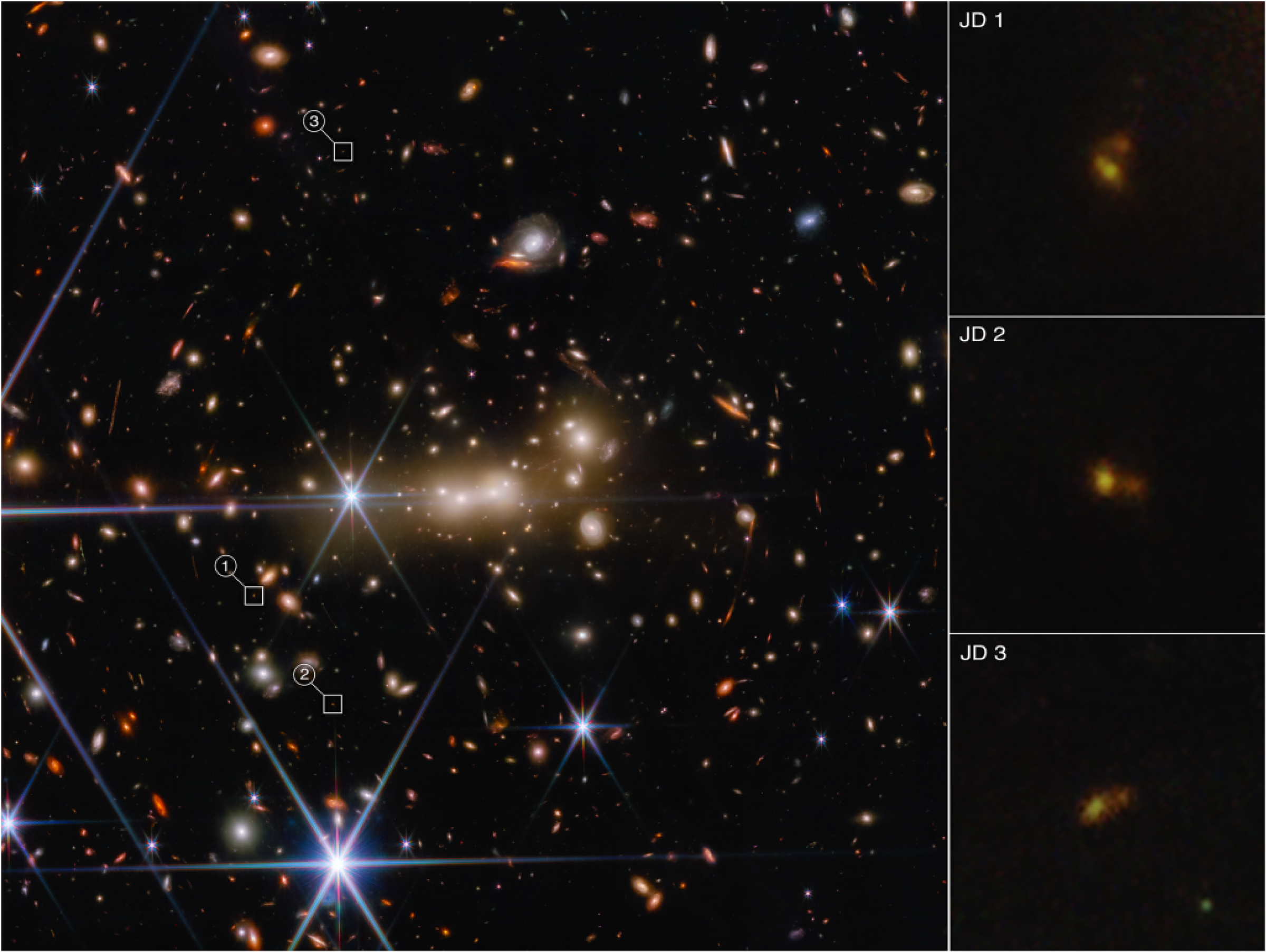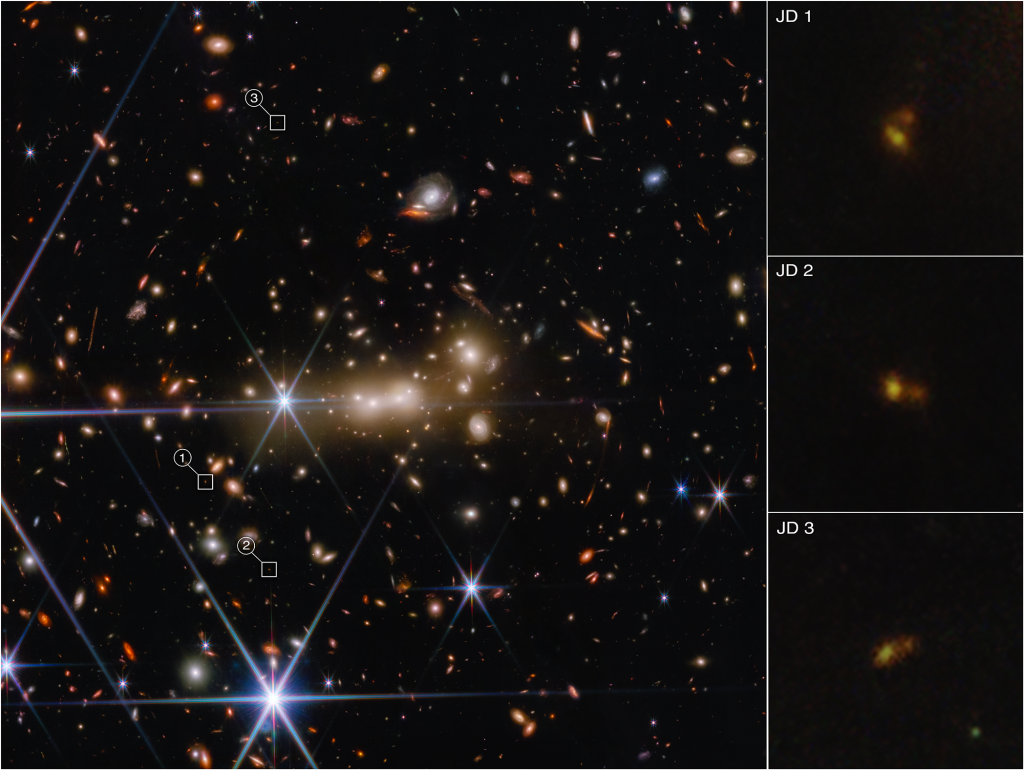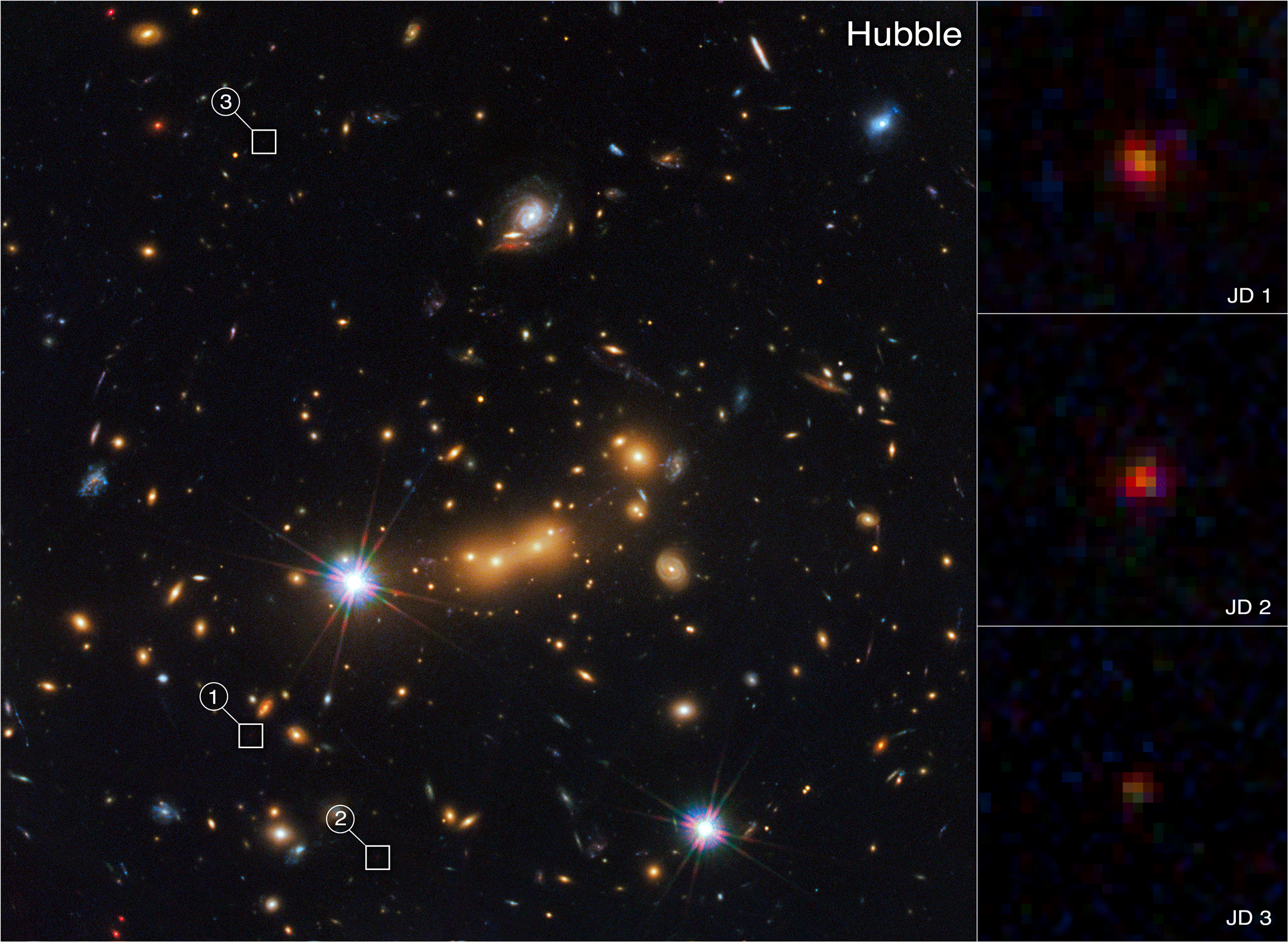Webb offre des détails inédits sur l'univers primitif
Posted By NASA, James Webb, Hubble Space Telescope News Maker on 26-10-2022 19:22:02

Description
Note de l'éditeur : cet article met en évidence les données de la science Webb en cours, qui n'ont pas encore été soumises au processus d'examen par les pairs.
Le télescope spatial James Webb de la NASA a été spécialement conçu pour détecter la faible lumière infrarouge des galaxies très éloignées et donner aux astronomes un aperçu de l'univers primitif. La nature des galaxies au cours de cette première période de notre univers n'est pas bien connue ni comprise. Mais avec l'aide de la lentille gravitationnelle d'un amas de galaxies au premier plan, les galaxies d'arrière-plan peu lumineuses peuvent être agrandies et également apparaître plusieurs fois dans différentes parties de l'image.

La gravité massive de l'amas de galaxies MACS0647 agit comme une lentille cosmique pour plier et amplifier la lumière du système MACS0647-JD plus éloigné. Il a également triplé le système JD, faisant apparaître son image à trois endroits distincts. Ces images, qui sont mises en évidence avec des cases blanches, sont marquées JD1, JD2 et JD3 ; des vues agrandies sont affichées dans les panneaux à droite. Dans cette image de l'instrument de caméra infrarouge proche (NIRCam) de Webb, le bleu a été attribué aux longueurs d'onde de 1,15 et 1,5 microns (F115W, F150W), le vert aux longueurs d'onde de 2,0 et 2,77 microns (F200W, F277W) et le rouge aux longueurs d'onde de 3,65 et 4,44 microns (F365W, F444W).
Aujourd'hui, nous nous asseyons avec trois astronomes travaillant sur Webb pour parler de leurs dernières découvertes. Les membres de l'équipe sont Dan Coe d'AURA/STScI pour l'Agence spatiale européenne et l'Université Johns Hopkins ; Tiger Hsiao de l'Université Johns Hopkins; et Rebecca Larson de l'Université du Texas à Austin. Ces scientifiques ont observé la galaxie lointaine MACS0647-JD avec Webb, et ils ont trouvé quelque chose d'intéressant.
Dan Coe : J'ai découvert cette galaxie MACS0647-JD il y a 10 ans avec le télescope spatial Hubble. À l'époque, je n'avais jamais travaillé sur des galaxies à décalage vers le rouge élevé, puis j'ai trouvé celle-ci qui était potentiellement la plus éloignée au décalage vers le rouge 11, à environ 97% du chemin du retour au big bang. Avec Hubble, c'était juste ce point rouge pâle. Nous pouvions dire qu'elle était vraiment petite, juste une minuscule galaxie dans les 400 premiers millions d'années de l'univers. Maintenant, nous regardons avec Webb, et nous sommes capables de résoudre DEUX objets ! Nous discutons activement de savoir s'il s'agit de deux galaxies ou de deux groupes d'étoiles dans une galaxie. Nous ne savons pas, mais ce sont les questions auxquelles Webb est conçu pour nous aider à répondre.
Tiger Yu-Yang Hsiao : Vous pouvez également voir que les couleurs entre les deux objets sont si différentes. L'un est plus bleu ; l'autre est plus rouge. Le gaz bleu et le gaz rouge ont des caractéristiques différentes. Le bleu a en fait une très jeune formation d'étoiles et presque pas de poussière, mais le petit objet rouge a plus de poussière à l'intérieur et est plus ancien. Et leurs masses stellaires sont aussi probablement différentes.
C'est vraiment intéressant de voir deux structures dans un si petit système. Nous assistons peut-être à une fusion de galaxies dans le tout premier univers. Si c'est la fusion la plus lointaine, je serai vraiment aux anges !
Dan Coe : En raison de la lentille gravitationnelle de l'énorme amas de galaxies MACS0647, il est divisé en trois images : JD1, JD2 et JD3. Ils sont amplifiés par des facteurs de huit, cinq et deux, respectivement.
Rebecca Larson : Jusqu'à présent, nous n'avons pas vraiment été en mesure d'étudier en détail les galaxies de l'univers primitif. Nous n'en avions que des dizaines avant Webb. Les étudier peut nous aider à comprendre comment ils ont évolué pour devenir ceux comme la galaxie dans laquelle nous vivons aujourd'hui. Et aussi, comment l'univers a évolué à travers le temps.
Je pense que ma partie préférée est, pour tant de nouvelles images Webb que nous obtenons, si vous regardez en arrière-plan, il y a tous ces petits points - et ce sont toutes des galaxies ! Chacun d'entre eux. C'est incroyable la quantité d'informations que nous obtenons et que nous ne pouvions tout simplement pas voir auparavant. Et ce n'est pas un champ profond. Ce n'est pas une pose longue. Nous n'avons même pas vraiment essayé d'utiliser ce télescope pour regarder un endroit depuis longtemps. Ce n'est que le début!

Il s'agit d'une comparaison entre les images du télescope spatial Hubble de MACS0647-JD de 2012 (informations de filtre sur Hubblesite.org) et les images de 2022 du télescope spatial James Webb (utilisant les mêmes attributions de couleurs que l'image ci-dessus). Notez que MACS0647-JD apparaît comme un point rouge pâle dans l'image Hubble, mais Webb révèle beaucoup plus de détails. Téléchargez la version pleine résolution du Space Telescope Science Institute. Crédits : SCIENCE : NASA, ESA, CSA, STScI et Tiger Hsiao (Johns Hopkins University) TRAITEMENT D'IMAGE : Alyssa Pagan (STScI)
Tags: james webb, nasa, esa, mission artemis, lescope, lescope spatial hubble
For more information, please Click HereRelated Blogs
Le vice-président Harris et le président français ont un premier aperçu de Galactic Get Together
L'IXPE de la NASA aide à résoudre le mystère du trou noir
"Ecoutez" les échos lumineux d'un trou noir
Web de la NASA révèle une atmosphère d'exoplanète comme jamais vue auparavant
Artemis I - Quatrième jour de vol
Ratings & Review
Popular Blogs
Climate Change Amnesty International
It’s easy to take our planet for granted until we see the human cost of its degradation: hunger, displacement, unemployment, illness and deaths. Millions of people are already suffering...
Free for dev - list of software-2 (SaaS, PaaS, IaaS, etc.)
Developers and Open Source authors now have a massive amount of services offering free tiers, but it can be hard to find them all to make informed decisions. This is a list of software (SaaS,...
Free for dev - list of software-3 (SaaS, PaaS, IaaS, etc.) (SaaS, PaaS, IaaS, etc.)
Developers and Open Source authors now have a massive amount of services offering free tiers, but it can be hard to find them all to make informed decisions. This is a list of software (SaaS,...
Recently Added Blogs
7 Men's Clothing Essentials To Maximize Style Statement
In today's fashion landscape, men's clothing basics are more than just attire—they define style and personality. Owning a solid wardrobe filled with style statements is the key to putting together...
Benefits of using electronic cigarettes
E-cigarettes have become a popular item for both smokers and nonsmokers in recent years. So, what are the attractions of e-cigarettes and what are the advantages of starting to use them? Here,...
Winter Skin Care
Winter Skin Care: 9 Measures You Need to Take Now Have you ever had that experience where you think you're doing a good job of moisturizing your skin every day, but then you realize it's...
Login to your Be found - Be connected account

Sign in by Email
Sign in with Social Media
Simple and convenient way for loggingNo Account yet? Click here to signup
Already have an account? Sign In
FEEDBACK / SUGGESTIONS
Give us your valuable feedback to make website more user friendly


Leave your details below







